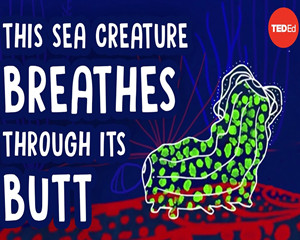Can you guess what you're looking at? Is it a fuzzy sock? An overripe banana? A moldy tube of toothpaste?
你能猜到你眼前的是什么吗?一只毛茸袜子?一根熟透了的香蕉?还是一管发霉的牙膏?
In fact, this is the humble sea cucumber, and while it might look odd, its daily toil paves the way for entire ecosystems to thrive.
实际上,这是一种不起眼的海参,尽管它可能看起来很奇怪,但是它每天都在为整个生态系统的繁荣铺路。
Sea cucumbers are members of the phylum Echinodermata, along with sea urchins, starfish and other radially symmetrical, "spiny-skinned" marine invertebrates.
海参,和海胆、海星以及其它放射对称型刺皮类海洋无脊椎生物一样,都属于棘皮类生物。
Some sea cucumbers have feathery tentacles flowing from their mouths, some are puffed like bloated balloons,
一些海参嘴里能吐出羽毛状的触角,一些则肿胀得像是被吹足气的气球,
and others simply look like Headless Chicken Monsters -- the actual name given to a rare deep-sea species.
还有一些则像是无头鸡怪--这实际上是该罕见深海物种的真实名字。
But they are generally characterized by their long, cylindrical shape.
但是它们的共有特征是长圆筒状体形。
A sea cucumber is essentially a brainless, fleshy form surrounding a digestive tract, bookended by a mouth and an anus.
海参本质上是一种围绕消化道并由嘴和肛门固定着的无脑肉质结构。
Adhesive tube feet run the length of their bodies and allow them to scoot along the seafloor.
胶管一样的触角长满全身,这允许它们沿着海底匍匐前进。
Specialized tube feet can be used for feeding and respiration, though many sea cucumbers actually breathe through their anuses.
这种经过特殊分化的管足可用于海参进食并呼吸,但是许多海参实际上也能通过肛门呼吸。
Rhythmically contracting and relaxing their muscles, they draw water in and out over an internal lung-like structure called a respiratory tree that extracts oxygen from seawater.
它们有节奏地收缩和放松肌肉,通过呼吸树这个内部肺状结构进行吸水和吸水,从而从海水中获取氧气。
Certain species of crabs and pearlfish take advantage of this rhythmic action and, once the sea cucumber's anus is dilated, they shimmy in and take shelter.
特定种类的螃蟹和珍珠鱼会利用海参这种有节奏的动作,一旦海参的肛门放松扩张,它们就会摇摆着躲藏进去。
The rear end of a single sea cucumber can harbor up to fifteen pearlfish at a time.
一头海参的尾部一次性最多可容纳15条珍珠鱼。
However, it seems that not all sea cucumbers put up with this intrusive behavior.
但是,似乎并不是所有海参都可以忍受这种入侵行为。
Some species are equipped with five teeth around their anus, suggesting that they may have taken an evolutionary stand against unwanted guests.
有些种类的海参肛门周围有五颗牙齿,这表明它们或许已进化到可以明确表达它们不欢迎不速之客的到来。
But even sea cucumbers that lack anal teeth are outfitted with tools to defend themselves.
但是,即使是肛门周围没有长牙齿的海参也配备了可以用来保护自己的工具。
They evade threats and launch counter-attacks using their mutable collagenous tissue, or MCT.
它们使用具有可变性的胶原组织(MCT),回避威胁并且发起反击。
This gel-like tissue contains bundles of collagen, called "fibrils."
这种包含束状胶原蛋白的凝胶状组织被称为“纤维”。
Proteins can interact with these fibrils to slide them together, stiffening the tissue, or apart, softening it.
蛋白质可与这些纤维进行相互作用,可以纤维交织在一起,使组织变硬,或分开纤维以软化组织。

This versatile tissue has many advantages:
这种多功能的组织拥有很多优势:
it aids in efficient locomotion, enables sea cucumbers to fit into small spaces, and allows them to reproduce asexually by splitting apart.
它帮助海参提升行动效率,使其适应狭小的空间,并允许它们通过分裂进行无性繁殖。
But MCT's most explosive application is employed when a predator attacks.
但遇到捕食者袭击时,MCT可以起到最具杀伤力的应用。
By loosening the attachments of internal tissues then quickly softening and contracting their muscles,
通过放松内部组织,之后快速软化并收缩它们的肌肉,
many species are capable of shooting a wide range of organs out of their anuses.
很多种类的海参都可以从肛门中向宽广区域范围射出器官。
This act is called "evisceration" and it's a surprisingly effective defense mechanism.
这种行为被称为弃除内脏,而这是一种非常有效的防御行为。
In addition to startling and distracting predators, the innards of some sea cucumber species are sticky and toxic.
除了可以分散掠食者的注意力,一些海参的内脏是具有黏性与毒性的。
Evisceration may seem drastic, but sea cucumbers are able to regenerate what they've lost to their gut reaction in just a few weeks' time.
弃除内脏看似过激,但是海参能够在短短几周内恢复因肠道反应而损失的器官。
Aside from the few species that have evolved to swim and those that feed without moving, many of these cumbersome creatures pass their time grazing the seabed.
除了少数进化成不需要移动就可以觅食的浮游物种外,大多数这些笨重的生物需要花费大量时间在海底进食。
Sea cucumbers are found everywhere from shallow shores to abyssal trenches 6,000 meters below sea level.
从浅滩到距离海面六千米深处,海参都随处可见。
On the deep sea floor, they comprise the majority of animal biomass, reaching up to 95% in some areas.
在深海的某些地区,海参数量可以占到动物生物总量的95%。
As these sausage-shaped wonders trudge along, they vacuum up sand, digest the organic matter it contains, and excrete the byproduct.
当这些香肠状的奇观们跋涉时,它们会吸入沙粒,消化其中含有的有机物并排出副产物。
In this process, sea cucumbers clean and oxygenate the seafloor by breaking down detritus and recycling nutrients.
在这一过程中,海参通过分解碎屑和回收营养,从而为海底进行清洁和充氧工作。
This creates the conditions for sea grass beds and shellfish to thrive.
这为海草以及贝类生物创造了良好的生长环境。
Sea cucumber excretions can also aid in coral formation and may play a role in buffering marine environments from ocean acidification.
海参的排泄物不仅可以促进珊瑚礁的形成,还起到了缓解海洋环境酸化的作用。
As the ocean's vacuum cleaners, they are very good at their job: about half of the sandy seafloor is thought to have passed through the digestive tract of a sea cucumber.
作为海洋的吸尘清洁工,它们非常擅长于自己的工作:大约一半的沙质海底被认为已经通过了海参的消化道。
So next time you're rejoicing in the feeling of sand crunching between your toes, consider this:
所以下次在你愉悦地享受沙子在脚趾间沙沙作响的感觉时,思考一下:
those very grains of sand might have, at one point or another, been excreted by a pickle that breathes through its butt.
这些沙粒也许在某个时间点,曾被这些通过屁股呼吸的“泡菜”给排泄出来。












